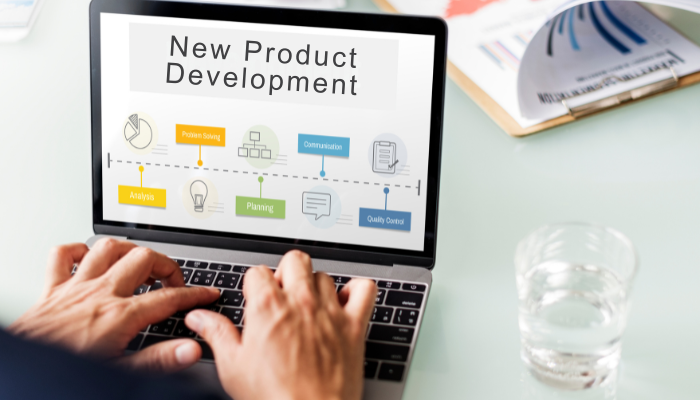“The secret of getting ahead is getting started.”
– Mark Twain
Launching a new product is no small feat. Each year, more than 30,000 new consumer products hit the market, yet 95% of them fail. Why? A well-structured New Product Development (NPD) process is often missing.
Understanding the NPD steps is important for turning an idea into a successful product. These steps help minimize risks and ensure that your product not only reaches the market but also stands out. With a clear framework, you can address potential pitfalls and build something that meets consumer needs.
This blog will guide you through the 8 essential steps of the NPD process, offering actionable insights to help you bring innovative and market-ready products to life.
Understanding the New Product Development Process: A Clear Overview
New Product Development (NPD) is all about turning your innovative ideas into real, market-ready products. It’s a step-by-step process that takes an idea from concept to launch, making sure it aligns with what your customers want. When you follow structured NPD steps, you ensure every phase of the journey is smooth and efficient.
Why is this process so important?
Without a solid plan, even the best ideas can miss the mark. NPD ensures you’re not just creating something new, but building a product that truly connects with the market. It’s not just about dreaming up something innovative—it’s about making sure it works.
Purpose of NPD:
- Bringing Innovation to Life: Developing unique solutions that your customers actually need.
- Creating Market-Ready Products: It’s about more than just ideas—it’s about launching products that are ready to thrive in the market.
- Reducing Risks: A well-organized process helps spot potential issues early and keeps you on the right path.
- Boosting Efficiency: The right NPD process can save time, money, and effort by keeping development streamlined.
In the next section, we’ll explore the 8 essential NPD steps of the new product development process, giving you a clear path from concept to product success.
Also read: Developing Your Product Strategy Framework: Essential Steps
Let’s get started!
Step 1: Idea Generation—The Starting Point of Innovation
Every successful product begins with a powerful idea. But how do you ensure your ideas stand out? The first of the 8 NPD steps is all about generating ideas that are innovative and practical. This is where creativity meets strategy, setting the foundation for your entire product development journey.
Let’s explore where these ideas come from and how you can make sure they’re aligned with your goals.
Internal Sources
- R&D Departments: Your research teams are great at coming up with fresh ideas. They know what’s trending in the market and how new technologies can help your product stand out.
- Employees: Don’t underestimate the insights your team can provide. Often, they have valuable ideas from their daily work that you might miss.
- Cross-Department Collaboration: When different departments share ideas, it sparks creativity. Bringing different perspectives together can lead to breakthrough solutions.
External Sources
- Customers: Your customers know what they want. Listening to their feedback through surveys or reviews gives you a clear picture of what’s working and what needs improvement.
- Distributors: Your distributors understand how products move in the market. They can point out gaps or opportunities you might not see.
- Competitors: Keeping an eye on your competition isn’t just about following trends. You can learn from their successes and mistakes to make your product better.
Utilizing Strategic Tools
- SWOT Analysis: This tool helps you figure out your strengths, weaknesses, opportunities, and threats. It’s a great way to get a clear picture of where you stand.
- Voice of the Customer (VoC): By really listening to what your customers are saying, you can make sure your product meets their needs and stands out in the market.
- Trend Analysis: Staying on top of trends helps you keep your product relevant and ahead of the curve when it’s time to launch.
Now that you have your ideas, it’s time to move on to the next phase in your NPD steps, where we start refining and developing them further.
Step 2: Idea Screening
Now that you’ve generated a pool of creative ideas, it’s time to separate the wheat from the chaff. This step, known as idea screening, is crucial in the NPD steps to ensure that only the most viable concepts move forward in your product development journey.
Objective: Filter Out Non-Viable Ideas Early
The main goal of idea screening, as part of your NPD steps, is simple: you want to weed out ideas that don’t have a realistic chance of success. Think of this step as a protective measure to save time and resources. By filtering out non-viable ideas early, you can focus on what really matters.
- Avoiding Wasted Effort: Engaging in thorough screening helps you steer clear of investing in ideas that won’t resonate with your market. You want to ensure your team’s energy goes toward concepts that have a chance to succeed.
- Cost-Effectiveness: Early detection of weak ideas saves you money in the long run. This step allows you to redirect resources to more promising concepts.
Methods for Idea Screening
There are several effective methods you can use during the NPD steps. Here are a few that have proven successful:
Expert Panels: Assemble a team of knowledgeable individuals from various backgrounds, such as marketing, R&D, and sales. These experts can provide valuable insights on the feasibility of each idea.
- Schedule regular brainstorming sessions with this panel.
- Encourage open discussions where every opinion is valued.
- Utilize their expertise to gauge market readiness.
Feasibility Questions: As part of your NPD steps, create a set of questions that helps assess each idea’s viability. Consider aspects like market demand, competition, and production costs.
- Is there a clear target audience for this product?
- What are the expected costs versus potential returns?
- How does this idea differentiate itself from existing products?
Market Research: Conduct initial research to understand market trends and consumer preferences. This data can help validate the concepts you’re considering as part of your NPD steps.
- Use surveys and focus groups to gather real-time feedback.
- Look into industry reports that analyze current market dynamics.
- Investigate competitors and their successful products.
In the next step, you’ll learn how to develop these selected ideas into concrete concepts ready for testing.
Step 3: Concept Development and Testing
After generating ideas, it’s time to bring those concepts to life. In this phase of the NPD steps, you’ll create detailed product ideas and then test them to ensure they meet your customers’ needs.
Let’s dive into how to effectively develop and refine your product concepts.
Development of Product Concepts
Detailed Product Creation: Start by outlining what your product will look like, how it will function, and what makes it unique. This is your chance to think creatively and imagine the details that will set your product apart in the market.
- What features will make your product appealing to customers?
- How will your product solve a problem or improve their lives?
- What materials or technologies will enhance your product’s value?
Visualizing the Concept: Create sketches or digital mock-ups as part of your NPD steps to help visualize your ideas. This makes it easier for everyone involved to understand what the final product might look like.
- Consider using tools like Canva or Sketch to create these visuals.
- Share your sketches with your team for initial thoughts and feedback.
- Keep refining your visuals based on input until you have a clear picture.
Testing with Target Consumers
Gathering Feedback: Use surveys, focus groups, or one-on-one interviews with potential customers as part of your NPD steps to get their thoughts on your concept. Their insights will be invaluable in refining your product to better meet their expectations.
- Ask open-ended questions to encourage detailed responses.
- Ensure you target a diverse group of customers for varied perspectives.
- Create a comfortable environment where they feel free to share honest feedback.
Iterative Refinement: Based on the feedback you gather, make adjustments to your concept. This process is crucial in the NPD steps as it ensures your product aligns with customer desires before moving forward.
- Document all feedback and categorize it into themes for easier analysis.
- Prioritize changes based on customer impact and feasibility.
- Share revised concepts with your audience to see how well they resonate.
Rapid Prototyping for Feasibility
Building Prototypes: Use rapid prototyping techniques as part of your NPD steps to create a working model of your product. This doesn’t have to be perfect; it’s about testing functionality and design.
- 3D printing is a great option for quick and cost-effective prototypes.
- Use everyday materials to create simple mock-ups if resources are limited.
- Aim for a prototype that captures the core features and functions of your idea.
Testing and Feedback Loop: Allow customers to interact with your prototype as part of your NPD steps. Their real-time feedback will highlight what works and what doesn’t, enabling you to make necessary adjustments early in the development process.
- Encourage users to think aloud while interacting with the prototype.
- Observe their behavior to understand their experience better.
- Be ready to make quick adjustments based on immediate feedback.
Great work on refining your product concepts! Let’s start thinking about how you’ll bring it to market.
Step 4: Marketing Strategy Development
Now that you’ve got a solid product concept, it’s time to think about how you’re going to bring it to market. This step in the NPD steps is all about crafting a marketing strategy that aligns with your goals and reaches your target audience effectively. Let’s dive in!
Defining Key Elements of Your Marketing Strategy
A successful marketing strategy involves several important components. Here’s what you need to focus on:
Target Market: Identify who your ideal customers are. Understand their demographics, preferences, and pain points.
- Are they young professionals, families, or seniors?
- What challenges do they face that your product can solve?
- How can you connect with them emotionally and practically?
Value Proposition: What makes your product unique? Your value proposition should clearly articulate why customers should choose your product over others.
- Highlight key features that set your product apart.
- Ensure your messaging resonates with your target audience’s needs.
Sales Objectives: Set clear, measurable sales objectives that guide your efforts.
- Are you aiming for a specific revenue target in the first year?
- What percentage of market share do you want to capture?
- Establish benchmarks to assess your progress.
Outlining Your Marketing Plan
Once you’ve defined your target market and value proposition as part of your NPD steps, it’s time to outline your marketing plan. This includes:
Pricing Strategy: Decide how you will price your product. Consider market demand, competitor pricing, and perceived value.
- Will you adopt a premium pricing strategy to position your product as high-end?
- Or will you offer competitive pricing to attract a broader audience?
Distribution Channels: Determine where and how your product will be sold.
- Will you use online platforms, brick-and-mortar stores, or a mix of both?
- How can you ensure easy access for your customers?
Marketing Budget: Allocate resources effectively to maximize your outreach.
- How much can you invest in advertising, promotions, and public relations?
- Which channels (social media, print, digital) will provide the best ROI?
Now that you know how you’ll reach your customers, it’s time to take a closer look at the financial side of things.
Step 5: Business Analysis
You’ve laid the groundwork with your marketing strategy, and now it’s time to delve deeper into the numbers. In this NPD step, you’ll conduct a business analysis to evaluate whether your product is not only a great idea but also a viable business opportunity.
Let’s explore how to ensure your product can stand the test of the market!
Evaluating Key Financial Aspects
To make informed decisions, you’ll want to look at several financial factors:
Sales Forecasts: Estimate how much of your product you can realistically sell. Consider factors like market size and competition.
- What’s the expected demand for your product?
- Are there seasonal trends that might affect sales?
- How can you adjust your forecasts based on feedback from potential customers?
Cost Estimates: Calculate all costs associated with bringing your product to market. This includes production, marketing, distribution, and overhead costs.
- What will it cost to manufacture your product?
- Are there hidden costs you haven’t accounted for, like shipping or packaging?
- How can you optimize your budget without sacrificing quality?
Profitability: Determine how much profit you can expect to make. This involves subtracting total costs from your projected sales revenue.
- What’s your break-even point?
- How long will it take to recoup your initial investment?
- Can you identify opportunities for improving your margins?
Decision-Making for Product Viability
After crunching the numbers, it’s time to assess the overall viability of your product:
Assessing Viability: Evaluate whether your product can succeed in the market. Look beyond the numbers to ensure alignment with customer needs.
- Does your product solve a significant problem for your target audience?
- How does it fit into the current market landscape?
- Are there enough potential customers willing to pay for it?
Customer Needs Alignment: Ensure your product addresses genuine customer pain points. This will help you create a loyal customer base.
- What feedback did you receive during earlier steps of the NPD process?
- How can you refine your offering based on customer insights?
- What additional features or changes would make your product more appealing?
Now that you’ve got a clear picture of the financial side of things, it’s time to dive into the nitty-gritty of product development.
Step 6: Product Development
Now that you’ve gathered insights and feedback from previous NPD steps, it’s time to dive into product development. This step transforms your ideas into a tangible product that meets customer needs.
Let’s break down how to make your product a reality while ensuring it meets all necessary standards.
Creating the Physical Product and Ensuring Design Meets Standards
Design with Purpose: Start by creating a detailed design that aligns with your product concept as part of the NPD steps. Use sketches or prototypes to visualize the product.
This is your chance to refine the aesthetics and functionality before moving into production. Collaborating with designers can help ensure that the product is both visually appealing and practical.
Ever feel like your customers are on a mystery shopping trip through your product experience? A well-designed customer journey can make all the difference. Codewave‘s Customer Journey Redesign service can help you map out a clear and intuitive path for your users, boosting satisfaction and sales.
Select Quality Materials: Choose materials that enhance your product’s performance and longevity. Consider factors like durability, safety, and cost-effectiveness.
For instance, if you’re developing a kitchen gadget, selecting food-safe materials is essential. This decision can impact customer satisfaction and your brand’s reputation.
Follow Industry Standards: Ensure that your product design adheres to relevant industry standards as part of your NPD steps.
This includes safety regulations, environmental impact guidelines, and quality benchmarks. Meeting these standards not only safeguards your customers but also builds trust in your brand.
Conducting Tests for Safety and Effectiveness Compliance
Implement Rigorous Testing: As part of your NPD steps, once your product is built, conduct thorough testing to ensure it is safe and effective. This may include user trials, laboratory tests, and performance assessments.
For example, if you’re developing a health-related product, clinical trials may be necessary to verify its efficacy.
Gather Feedback from Tests: Collect feedback from test users to identify any issues or areas for improvement. Are there features that users find confusing or ineffective? Addressing these concerns early on can save time and money later in the process.
Refine Based on Findings: As part of your NPD steps, use the insights from testing to make necessary adjustments. This might mean modifying design elements, improving functionality, or enhancing user experience. Your goal is to create a product that not only meets but exceeds customer expectations.
Want your product to stand out from the crowd? Codewave‘s branding services can help you craft a unique and memorable brand identity that resonates with your target audience.
Now that you have a physical product, it’s time to see how it performs in the real world.
Step 7: Test Marketing
As you reach Step 7 in your NPD process, you’re on the verge of turning your idea into a market-ready product. This is where test marketing comes into play. It’s an exciting stage where you can see how your product performs in real-world settings.
But how do you ensure this step is effective? Let’s break it down.
Implementing the Product in Controlled Market Settings
Select Test Markets: As part of your NPD steps, choose a few target locations that represent your broader audience. This could be a specific city or demographic segment. Picking the right test market is crucial because it allows you to gather insights that are more reflective of your overall customer base.
Launch Your Product: Introduce your product to these markets. A soft launch can be beneficial, allowing you to gauge initial reactions without overwhelming your team or your budget. This step is essential as it gives you a glimpse of how the market will respond to your product.
Monitor Sales and Feedback: As part of your NPD steps, keep a close eye on how the product performs. Are customers buying it? What are their initial impressions? Utilize tools like surveys, social media, and direct customer interactions to collect real-time feedback. Listening to your audience during this phase is key.
Adjusting Based on Market Tests and Focus Group Feedback
Analyze Feedback: After gathering initial data, take the time to review customer feedback. Look for common themes: Are there specific features that customers love or dislike? Understanding these insights will help you refine your product.
Make Necessary Adjustments: Based on your findings from the NPD steps, tweak your product as needed. Whether it’s modifying a feature or improving packaging, responding to customer input is vital to a successful NPD process.
Conduct Focus Groups: After making adjustments, consider organizing focus groups to test the modified product. This will help you confirm that the changes resonate with your target market and provide further insights for refinement.
Step 8: Commercialization
You’ve done the groundwork, and now it’s time to shine. Step 8 in your NPD process is commercialization, where your product finally meets the market. This phase is not just about launching; it’s about doing it smartly to ensure your product stands out and thrives.
Let’s explore how to make your launch a success.
Launching the Product with Strategic Considerations of Timing and Location
Plan Your Launch Timing: Timing can make or break your product launch as part of your NPD steps. Consider launching during a period when demand for your type of product is at its peak.
For example, if you’re launching a new gadget, aligning your release with the holiday shopping season can boost visibility and sales.
Choose Strategic Locations: Determine where you will first introduce your product. Focus on regions or markets that align with your target audience.
A well-planned location can lead to better customer engagement and initial sales. Think about starting in urban areas where trends often gain traction before expanding elsewhere.
Develop a Marketing Strategy: Your marketing approach should be as dynamic as your product and aligned with your NPD steps. Utilize digital marketing, social media, and local events to promote your launch.
Make sure your messaging clearly communicates the value your product brings. Engaging content, such as videos and customer testimonials, can create excitement and anticipation.
Ongoing Monitoring and Strategy Refinement Post-Launch
Track Performance Metrics: Once your product is launched, closely monitor its performance. Look at sales figures, customer feedback, and market trends.
This data will be invaluable in understanding how well your product is received. Tools like Google Analytics can help track user engagement on your promotional content.
Be Ready to Adjust Your Strategy: Based on the insights you gather during the NPD steps, don’t hesitate to refine your approach. If certain marketing tactics aren’t delivering results, pivot your strategy.
For instance, if customers love a particular feature, highlight it more in your promotional efforts.
Engage with Your Customers: Keeping an open line of communication with your customers is essential throughout the NPD steps. Use surveys and social media to gather ongoing feedback.
This not only helps you improve your product but also builds a loyal customer base. Remember, satisfied customers can become your best brand ambassadors.
Conclusion
You’ve explored the eight crucial steps of the NPD process. Remember, NPD isn’t just about creating something new; it’s about creating something that resonates with your customers and solves a real problem for them. As the quote says, “A lot of times, people don’t know what they want until you show it to them. You have to be a leader and take a leap of faith.“
Developing a successful new product can be a challenging yet rewarding journey. By following a structured NPD process and maintaining your focus on customer value, you can significantly enhance your chances of bringing a winning product to market.
At Codewave, we specialize in guiding you through each of the NPD steps to ensure a successful launch. Explore our New Product Development Services here to discover how we can help you turn your ideas into successful products.
Start your new product development journey with a focus on customer value and effective risk management. By partnering with Codewave, you’ll gain the expertise necessary to refine your NPD steps and succeed in a competitive market.
Also watch: What Is the Product Development Cycle?
Codewave is a UX first design thinking & digital transformation services company, designing & engineering innovative mobile apps, cloud, & edge solutions.







